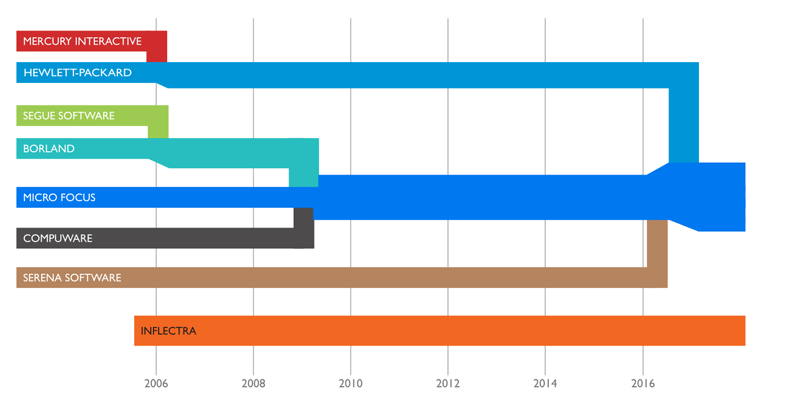September 9th, 2016 by Adam Sandman
When we first started the company, back in 2006 we had many legacy competitors offering integrated requirements, test and defect tracking systems. However as the years have rolled on and with the rise of more nimble competitors, it seems that they have been gobbled up, most recently HP ALM by Micro Focus!
Way Back in 2006
When we started Inflectra in 2006 we were one of the first companies to offer a web-based test management system. Our competitors at the time included:
- Mercury Interactive - TestDirector
- Compuware - QACenter Enterprise
- Segue - SilkCentral
- Serena - TeamTrack
- TechExcel - DevTest/Suite
- Empirix - eManager
- Seapine - TestTrackPro
- TestLink
- QaTest
- ApTest
If you look at the industry over that period, it's striking how many of these companies have ended up becoming one company. In fact today, HPE announced that it was selling its software portfolio to competitor Micro Focus (that had already purchased Compuware, Borland, Segue, and Serena)

Many of the others no longer exist or we don't hear about much any more.
So What Is The Take Away?
During the last ten years we've seen many new companies enter this space, with SaaS web-based solutions (TestRail, TestStuff, QMetry, etc.) that like us provide a more more affordable and easier to use solution than the legacy players.
For customers, it means when you choose a company to be your provider of ALM and testing solutions, pick a company that focuses more on product development than on fancy offices or corporate mergers and acquisition!
What we find interesting is that those companies that survived have done so by continually reinvesting in their technology and frankly re-inventing their technology stack, moving from client/server UIs to web-based, from traditional web to AJAX Web 2.0, from on-premise to SaaS (or providing both like us).
The challenge now is to make everything mobile first (witness our release of SpiraTest 5.0 with the new fully mobile-responsive UI). The companies that were content to use the same architecture because customers weren't demanding changes, those that didn't have the refactoring imperative to renew every day are now just names in the history book...
The subject of the refactoring imperative will be the subject of a future article....